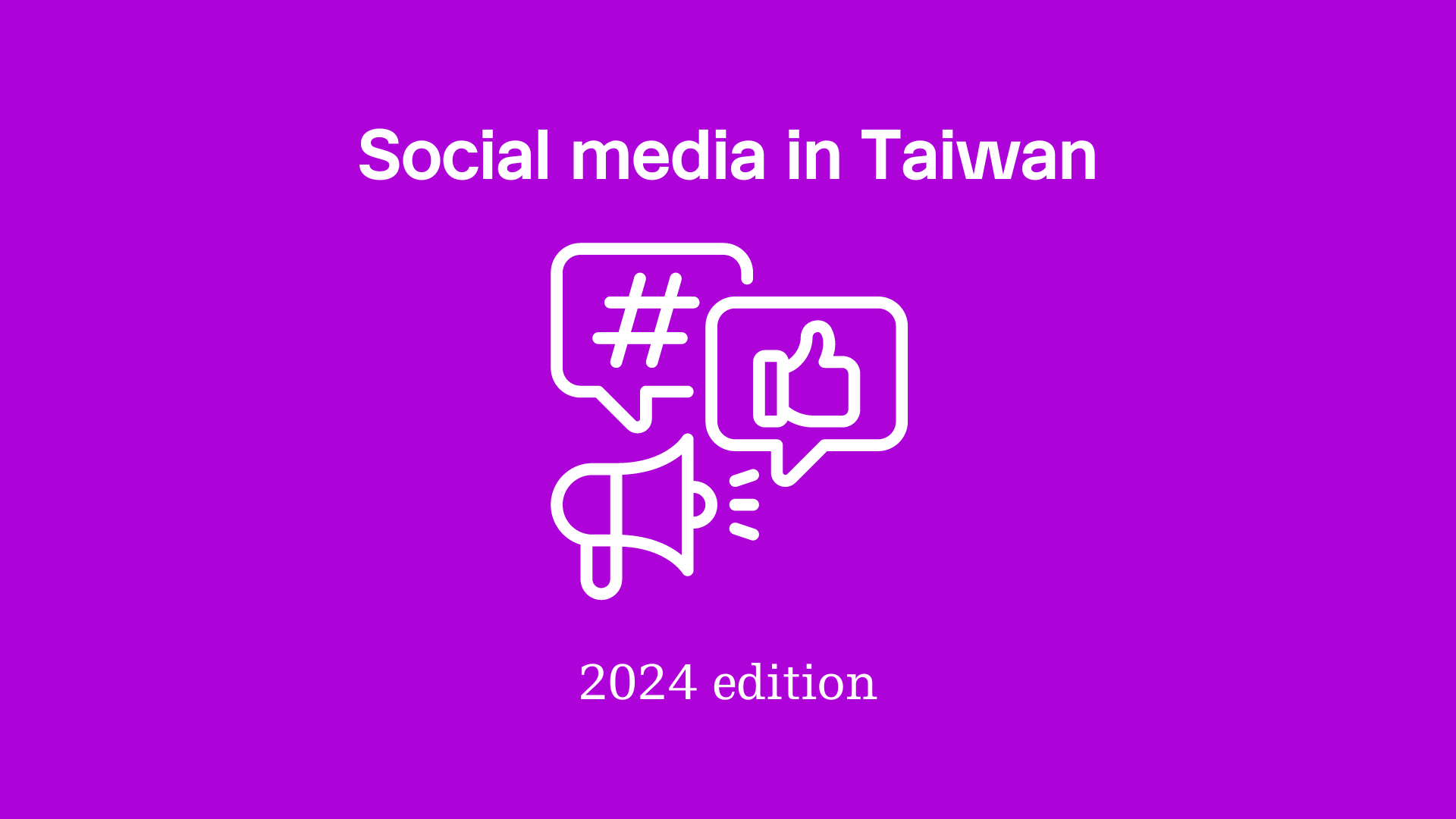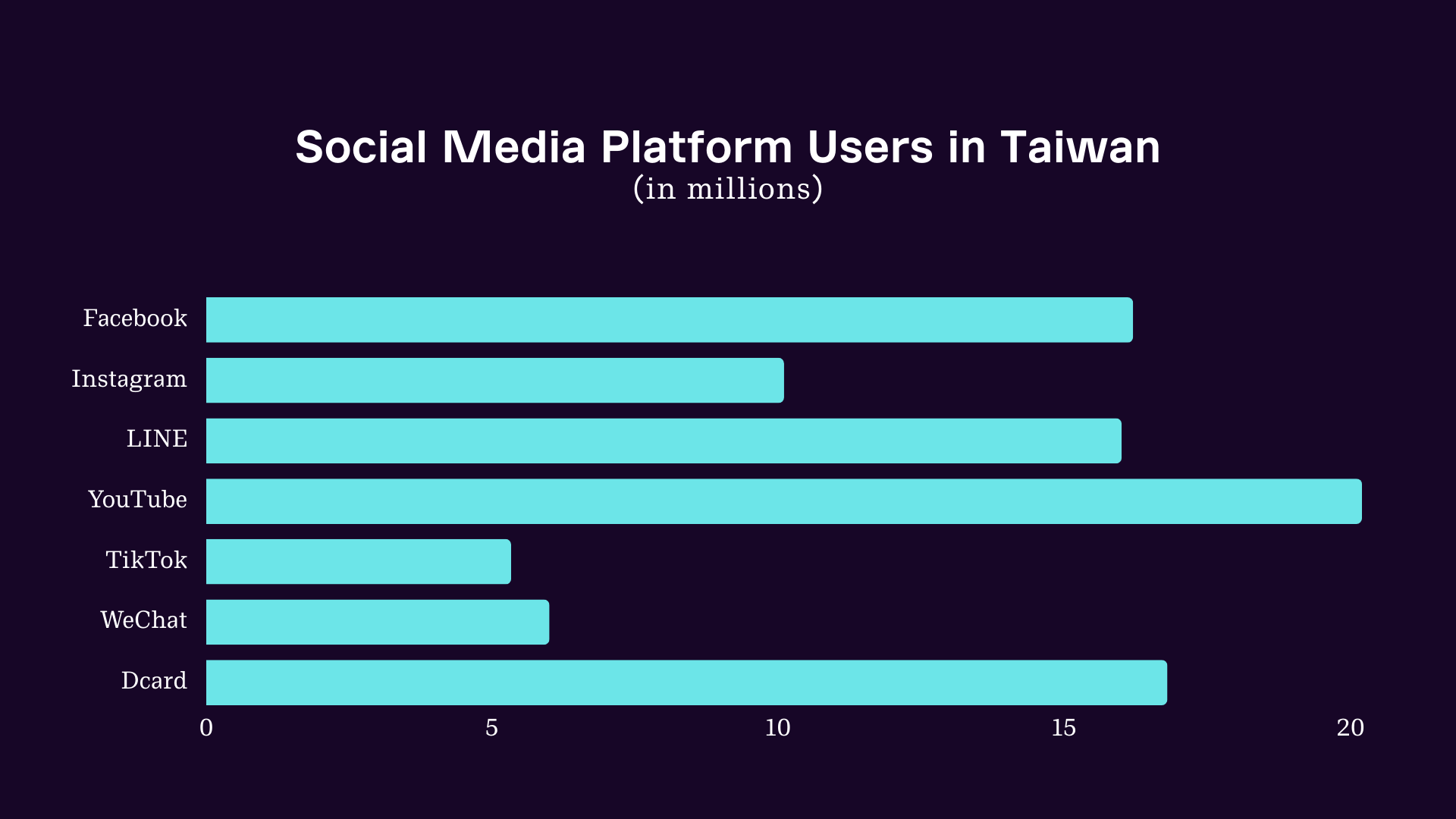Insights >
Most Popular Social Media in Taiwan in 2024


New: 2025 Japanese Marketing Calendar | download for FREE >>


In Taiwan, where internet and smartphone usage is high, social media usage is also quite popular.
About 90% of the population actively uses one or more social media platforms. According to a study by GWI, the average Taiwanese individual has accounts on around 6.5 different social media platforms. This includes popular platforms like Facebook and Instagram and local brands such as PTT and Dcard.
 Source: OOSGA
Source: OOSGA
LINE has become Taiwan’s most popular social media platform, surpassing Facebook in 2018. Most Taiwanese still use Facebook, but younger generations prefer platforms like TikTok, Xiaohongshu, and Dcard for trends. It is worth noting that PTT is the most popular forum in Taiwan.
LINE is the top social media in Taiwan, but Facebook & Instagram are also popular with young people for sharing and connecting. Users mainly use LINE as a messenger despite its attempts to become a “super-app.” LINE’s social features are not widely utilized.
 Source: INSG.
Source: INSG.
Despite its global dominance, Facebook remains significant in Taiwan’s social media scene.
People of all ages use Facebook to connect with others, share content, and engage with communities. Recently, Facebook has added features like videos, live streaming, and online shopping, making it popular for businesses and influencers.
Instagram continues to captivate Taiwan’s younger demographic, emphasising visual storytelling and aesthetic expression.
The platform’s popularity among millennials and Gen Z users fuels a vibrant ecosystem of influencers, artists, and brands. Instagram is a virtual showcase of Taiwan’s cultural richness and creativity, from picturesque landscapes to culinary delights. With features like Stories, Reels, and IGTV, content creators have ample opportunities to engage and inspire their audience.
YouTube reigns supreme as the ultimate destination for video content consumption in Taiwan.
The platform has a vast video range, including vlogs, tutorials, music videos, and documentaries, for entertainment and learning different topics. Local creators have succeeded in travel, gaming, and tech reviews, gaining loyal fans and making money through ads and sponsorships. Moreover, YouTube’s live streaming capabilities facilitate real-time interaction, fostering a sense of community among viewers.
As a homegrown platform, LINE holds a special place in the hearts of many Taiwanese users.
Originally launched as a messaging app, LINE expanded its offerings to include services like news, gaming, shopping, and mobile payments. LINE’s integration with everyday activities, cute stickers, and localised features make it a staple in Taiwanese digital culture. Businesses leverage Line’s official accounts and chatbots to provide customer service, promote products, and facilitate transactions seamlessly.
Read our blog on the potential of using the LINE app in Taiwan.
TikTok has taken Taiwan by storm with its addictive short-form videos and viral challenges.
The platform’s algorithm-driven feed surfaces personalized content, keeping users engaged and entertained for hours. Taiwanese creators showcase their talents through dance routines, comedic skits, and creative experiments, garnering millions of views and followers. Brands are tapping into TikTok’s advertising opportunities to reach younger demographics and capitalize on trending content formats.
WeChat remains a vital communication tool for Taiwanese users with connections to mainland China.
Many Taiwanese people and businesses use WeChat to communicate and do business with counterparts in China despite political tensions. WeChat’s Mini Programs allow users to easily access food delivery and banking services, making the app an integral part of daily life for many people.
PTT is one of the largest online forums in Taiwan, founded in 1995. It covers many topics, including technology, entertainment, news, lifestyle, etc.
Users know PTT for its diverse user base and active discussions on various subjects. It operates similarly to Reddit, with users able to post topics (known as “boards” or “bbs”) and engage in discussions through comments.
Each board on PTT is for a different topic, like movies, music, gaming, photography, school subjects, and local interests. PTT’s interface is simple and text-based, focusing on discussion rather than visual content.
Dcard is a popular online community and social networking platform primarily targeted towards younger generations, particularly college students and young adults.
It launched in 2014 and quickly gained popularity among millennials and Gen Z in Taiwan. Dcard is structured around interest-based communities (known as “forums” or “departments”). It’s similar to PTT and Reddit—users can discuss various topics, share experiences, ask questions, and seek advice.
Unlike PTT, Dcard has a more modern and visually appealing interface, supporting images, gifs, and videos. It also allows users to follow specific topics and customize their feeds based on their interests. Dcard’s content focuses more on lifestyle, relationships, fashion, education, and personal experiences. It reflects the interests and concerns of its predominantly younger user base.
Each platform offers unique opportunities and challenges for users and businesses in Taiwan’s dynamic social media landscape.
Taiwanese netizens can connect with others online through Facebook, Instagram, and PTT. They can share personal stories, creativity, and engage in discussions easily on these platforms. Social media will continue to impact communication, collaboration, and content consumption in Taiwan as technology and society evolve.
Those changes in technology and society will shape how people in Taiwan use social media in the future. Social platforms will play a significant role in how people in Taiwan communicate, collaborate, and consume content in the future.
 Need support starting or growing your business in Taiwan? Contact DMFA consulting team to get more information.
Need support starting or growing your business in Taiwan? Contact DMFA consulting team to get more information.
Simply fill in the form and our team will get back to you as soon as possible →